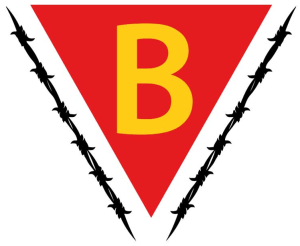
Fort Breendonk was built in the early 1900s to protect Antwerp, Belgium, from possible German invasion. Damaged at the start of World War I, it fell into disrepair . . . until the Nazis took it over after their invasion of Belgium in 1940.
Never designated an official concentration camp by the SS, it was labeled an Auffanglager, a type of camp where prisoners—Jews, communists, resistance fighters, and common criminals—were held until they were either released or transported to other concentration camps. No matter what term the Nazis used, most people familiar with Breendonk during and after the war referred to it as a concentration camp. It was just as brutal and deadly, according to many of its prisoners. One man who survived Breendonk wrote that although the camp “had no gas chambers, no incinerators . . . Breendonk was no less notorious, no less a black hell of the most barbarous terror.” Another claimed that he “would prefer to spend nineteen months at Buchenwald than nineteen days at Breendonk.” A historian describing the concentration camp of Auschwitz I before the nearby extermination camp of Auschwitz-Birkenau was built wrote that the camp “was widely known as a site of imprisonment, extreme brutality, starvation, illness, and high mortality rates, including killings by various forms of torture, shooting, and hanging.” The same description could be applied to Breendonk, only on a smaller scale.
Like most non-Belgians, I had never heard of Breendonk until September 2010, when I visited it while on vacation in Belgium. It took only a few minutes to realize that I not only wanted to know more about the camp, I wanted to write a book about it. I was haunted by the stories and the photographs of the prisoners that hung on exhibit in the dark and dank rooms of the camp.  One image in particular stayed with me: a photograph of a man named Israel Neumann. It was his heartbreaking story that propelled me to learn more about Breendonk and its prisoners.
One image in particular stayed with me: a photograph of a man named Israel Neumann. It was his heartbreaking story that propelled me to learn more about Breendonk and its prisoners.
I made at least a dozen visits to Belgium and Breendonk as I worked in its archives, wandered through its echoing deserted hallways on rainy afternoons, studied the stucco wall in the courtyard, stepped into the torture chamber, and stood in silence on the execution grounds. I also met with relatives of some men who had been imprisoned there. The stories woven through this book are taken from autobiographies, interviews, archival documents, and courtroom testimonies. I did not invent any dialogue; every word that appears in the conversations was quoted from one of these sources. The only imagination I used was when he described what a prisoner might have experienced, and these suppositions were based on the writings of other prisoners. I have included photographs, often undated, of many prisoners as well, so that the reader can see their faces. But photographs were not available for everyone, especially those who died and had no surviving family. This was true of many Jewish prisoners whose families were deported to their deaths.
Other Books By - James Deem
Terug


 De gevangenen van Breendonk
De gevangenen van Breendonk